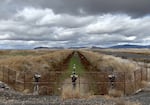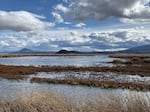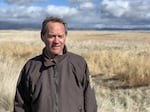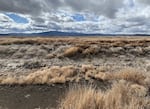
A dry canal at Lower Klamath National Wildlife Refuge.
Erik Neumann / JPR News
Just off Stateline Highway, about 100 feet into California from the Oregon border, Klamath National Wildlife Refuge Manager Greg Austin stands on the edge of a marsh. There are flocks of mallards and some geese, but as one of America’s main stopovers for migratory birds, this wetland is almost completely dry this year.
“This is the only water we have. And we can get 5,000 birds down here right now,” he said.

Fifty acres were flooded at the Lower Klamath National Wildlife Refuge in October 2021. The refuge complex should have around 20,000 acres with water in the fall to support hundreds of thousands of migrating birds, according to Refuge Manager Greg Austin.
Erik Neumann / JPR News
Five thousand? They should have 700,000 birds this time of year.
Big rig trucks zoom past on the highway, stacked high with onions from nearby farms. They also rely on this water. Austin says when the Klamath Basin is wet, it produces food for all sorts of bird species.

Klamath National Wildlife Refuge Manager Greg Austin
Erik Neumann / JPR News
“When this place is doing its job, it’s fun to watch,” he said. “It’s just incredible to see this place do what it can do.”
If you look at a map of the North American bird migration route known as the Pacific Flyway, the Klamath Wildlife Refuge Complex is like the narrow middle of an hourglass. Birds flying between the Arctic and Mexico are funneled into this series of six lakes and marshes. They rest and eat wetland plants and grains from farm fields to refuel for the rest of their journey.
Lower Klamath National Wildlife Refuge was created in 1908 by President Teddy Roosevelt. It was the nation’s first waterfowl refuge, and it was specifically set aside to protect wild birds.
Austin says they might fly for a whole day before stopping here.
“It’s an ancient highway,” he said. “These birds have been using this flyway forever.”

A depiction of the Pacific Flyway route. Historically, birds from around North America congregate at the border of Oregon and California in the Klamath Basin during their fall and spring migrations.
Courtesy / U.S. Dept. of Fish & Wildlife
But with neither water nor plants to feed on this year, they’re skipping the Klamath refuges.
Caroline Brady is the waterfowl program supervisor for the California Waterfowl Association. Lately, she’s been banding birds in the Sacramento Valley.
“You’re seeing more species arrive earlier, and overall, everybody seems to be pounding the food,” she said.
Some birds have arrived worn out because of their longer-than-usual trip to California.
“They’re hungry customers once they’ve made it here this year,” Brady said.
Craig Isola manages a different group of refuges at the Sacramento National Wildlife Refuge Complex in California, most of which are wetlands for migratory birds.
“We saw big numbers of snow geese arriving in early October in the tens of thousands,” he said. “And those generally don’t show up until the last week of October or the first week of November. So, almost a month early.”
Isola says as droughts have made water less dependable in the Klamath Basin, it’s becoming a trend for birds to arrive early in the Sacramento Valley.
“It’s putting another added burden on the wetland food resources of the Sacramento Valley because it’s a finite resource. And if there’s more birds for a longer period it could impact the overall carrying capacity,” Isola said.
Even in drought years like this one the Sacramento refuge complex is entitled to 75% of its usual water allocation when balanced against other users like agriculture under the Central Valley Project Improvement Act. The Klamath Basin complex is less fortunate.
The Klamath refuge complex receives water delivered through the Bureau of Reclamation’s Klamath Project after agricultural users and the Klamath tribe, which has senior water rights. So while the Klamath refuge often lacks the water it needs, during drought years it is the first user to go without.
Brady says large numbers of birds arriving early can also be a problem for harvest season in the heavily farmed Central Valley.
“That just precipitates more wildlife-agriculture conflict because you have these hungry birds that have flown hundreds if not thousands of miles to get here and their usual stop off spot is not available,” she said.
A spokesperson from the California Rice Commission said the rice industry did not experience much conflict with migratory birds this year. But future droughts that disturb migration are very possible.

Lower Klamath National Wildlife Refuge in October, after a year of exceptional drought.
Erik Neumann / JPR News
According to a report this year from the Oregon Climate Change Research Institute based at Oregon State University, models project warmer and drier summers in Oregon and less winter snowpack. Those factors increase the likelihood of more droughts.
With the collapse of a previous Klamath Basin water sharing agreement in 2015, consecutive drought years have ratcheted up tensions over water between farmers, Native tribes and wildlife advocates.
Austin says the only way to take care of the basin is to rebuild those partnerships. Dry conditions like these could be increasingly common in the years ahead.
“We need all the groups to get hopefully back together and see if we can come up with some long-term agreement that we can all work with and live with,” he said

